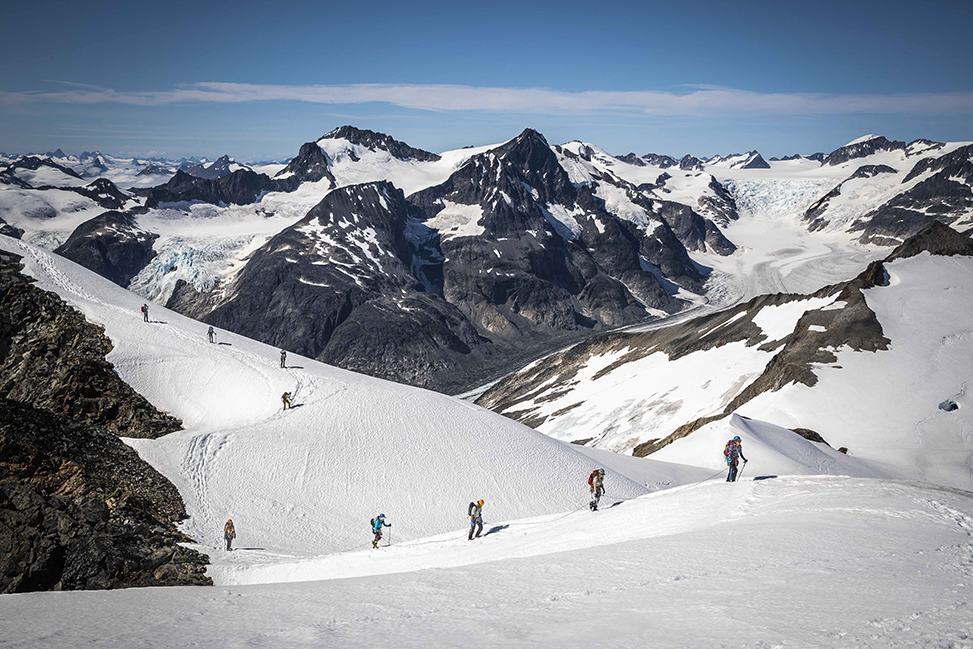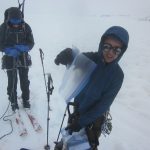
The Gilkey Trench of the Juneau Icefield, where the Gilkey and Vaughan-Lewis glaciers flow through a deep, glacially carved valley. The trench has a beautiful pattern of repetitive, wave-like “ogives” created by the ice falls. (photo by Andrew Opila)
After spending two months on a research expedition in Alaska last summer, UNC junior Carly Onnink shares her story of field-based discovery.
The evening light encircled us in a 360-degree sunset of pink and orange over a mountain horizon, a brilliant display against the stark-white ice field in August. We nursed mugs of hot Tang, crowded together on our sleeping pads in a dug-out bench in the snow. As the evening grew cooler, we started to shuffle toward our sleeping bags and tents.
But then someone asked, “Who’s up for a night ski?”
We all buckled up our ski boots and took off, kicking and gliding as the sunset darkened into the night sky. We trekked to a crest with a view of crevasses leading into an ice fall, and watched the moon rise between two mountain peaks as lightning flashed among storm clouds too distant to hear — the perfect end to an exciting day collecting ice cores on Alaska’s Juneau Icefield.
The Juneau Icefield Research Program (JIRP) has over 70 years of history, making it one of the longest continuous glacier monitoring programs in the world. During a two-month expedition each summer, a team of scientists, students and safety staff from around the world traverses the 1,500-square-mile expanse between Juneau, Alaska, and Atlin, British Columbia.

Technical tasks
JIRP gives students an immersive and unparalleled field experience. Founded with the principles “books, nature, action,” it teaches students through fieldwork and nightly academic lectures. Students work in teams to conduct a research project with a faculty mentor, and in the process they experience a remote, ever-changing landscape firsthand. The ice field is beautiful but hazardous. Students get hands-on safety training from an expert mountaineer and practice rescuing each other from crevasses. Students also learn skills such as walking on ice in crampons, skiing while tied to a rope team and stopping a fall with an ice axe.
My research team’s project was to identify the origin of the ice in the Juneau Icefield. Before it fell as snow, this water evaporated from somewhere in the ocean. To find this location, we use several sets of clues, one of which was the temperature at which the water first evaporated. But how can we find that?

We used water isotopes — forms of the same element that have different masses — as a related parameter for temperature. The ratio of heavy to light isotopes changes as water changes phase. Lighter isotopes will more readily evaporate from the ocean; heavier isotopes will more readily precipitate from clouds.
Using a computer model, we translated the isotope ratios from snow samples collected during the 2017 field season into their original evaporation temperatures. Next, we identified where these temperatures could have occurred over the surface of the ocean, then mapped how wind could have carried the moisture to Juneau Icefield.
Understanding water transport to Juneau Icefield is important in predicting the future snow accumulation and health of Alaskan glaciers, which are rapidly declining and contributing to rising sea levels.
Fieldwork, teamwork and tough terrain
My team’s fieldwork included collecting surface samples. This meant long ski days, stopping every kilometer to scoop snow into a bottle, maneuvering around crevasses along the way. Gathering data sometimes required traveling far from our base camps and spending several nights in tents on the ice field.
An expedition like this requires perseverance — and a lot of foot care. Eight or so hours a day in ski boots can take a toll. JIRPers were encouraged to treat problem-spots before they developed into blisters, then debilitating sores. This was not a place to try to tough it out.
My personal challenge was tendonitis, which snuck up on me during my second hike. The field medics and safety staff taught me how to tape my ankles for better support, and I picked rest days strategically before full-day traverses.

Whatever our aches or pains, we made long journeys across the ice field, such as a two-day, 30-mile trek between our first and second camp, despite wet weather and soggy socks or in mist with 10-foot visibility. But reaching our destination as a team was always deeply rewarding, especially climbing the last 100 feet as the first trail party danced and cheered us into camp.

Many facets of discovery
JIRP is also an area of intersection between art, writing and science. Our expedition included a faculty artist, and we learned how to field-sketch and create cyanotypes, which are photographic prints that turn blue with UV light. Art is a wonderful opportunity to depict the ice field and communicate an understanding of our natural surroundings. I was able to use the expedition as fuel for my creative writing and set aside time to work on poetry each day.
I embarked on JIRP as a biology major with research experience in a nutrition laboratory, but I wanted to experience true field research. In JIRP, faculty are passionate about understanding the landscape around them and fuel curiosity in students. I love being immersed in the field. I’m excited to learn more geology and build on what I’ve learned during the remainder of my academic career at UNC.
Special thanks go to my research partners, Nadia Grisaru and Scott Lakeram; our mentor, Bradley Markle of the University of California Santa Barbara; and the entire JIRP staff and faculty. The 2018 field expedition included two fellow Tar Heels, Eric Zhu and Zac Horine.
(Click on photos below to make them larger.)


By Carly Onnink ’20
Read a poem about Onnink’s experience in our Finale feature.
Published in the Spring 2019 issue | Features
Read More

Professor, folklorist and Grammy winner: Bill Ferris
Carolina professor emeritus of history and folklorist William Ferris looks…

#Throwback, spring 2019: Military March
This 1942 photo, taken by famed photographer Hugh Morton, shows…







